AT&T SB67138 User Manual
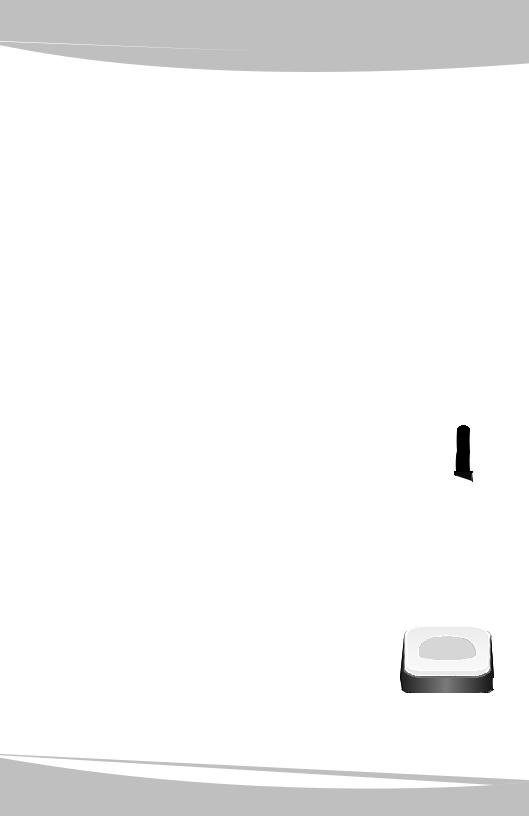
User’s manual
SynJ SB67138
DECT 6.0 4-line corded/cordless small business system
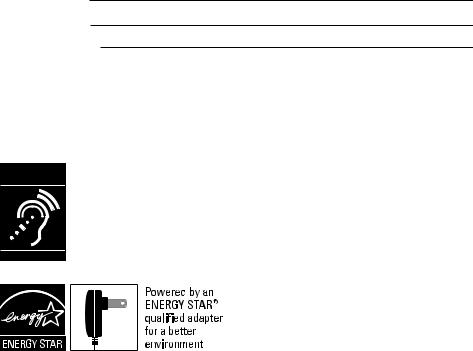
Congratulations
on your purchase of this AT&T product. Before using this AT&T product, please read the Important safety information on pages 86-87 of this manual. Please thoroughly read this user’s manual for all the feature operations and
troubleshooting information necessary to install and operate your new AT&T product. You can also visit our website at www.telephones.att.com or call 1 (888) 915-2007. In Canada, dial 1 (866) 288-4268.
Model number: SynJTM SB67138
Type: |
DECT 6.0 4-line corded/cordless small business system |
Serial number:
Purchase date:
Place of purchase:
Both the model and serial numbers of your AT&T product can be found on the bottom of the telephone base.
Save your sales receipt and original packaging in case it is necessary to return your telephone for warranty service.
Compatible with Hearing Aid T-Coil
T
TIA-1083
Telephones identified with this logo have reduced noise and interference when used with most T-coil equipped hearing aids and cochlear implants. The TIA-1083 Compliant Logo is a trademark of the Telecommunications Industry Association. Used under license.
The ENERGY STAR® program (www.energystar.gov) recognizes and encourages the use of products that save energy and help protect our environment. We are proud to supply this product with an ENERGY STAR® qualified power adapter meeting the latest energy efficiency guidelines.
© 2010 Advanced American Telephones. All Rights Reserved. AT&T and the AT&T logo are trademarks of AT&T Intellectual Property licensed to Advanced American Telephones, San Antonio, TX 78219. Printed in China. SynJTM is a trademark of Advanced American Telephones.
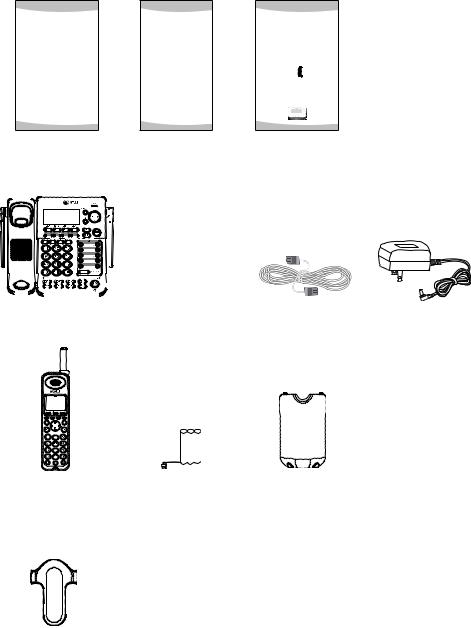
Parts checklist
Check to make sure the telephone package includes the following items:
User’s manual |
SynJ SB67138 |
DECT 6.0 4-line corded/cordless |
small business system |
Quick start guide
SynJ SB67138
DECT 6.0 4-line corded/cordless small business system
User’s manual
SynJ SB67108
DECT 6.0 expansion handset for use with AT&T model SynJ SB67118/SB67138
Quick start guide
SynJ SB67108
DECT 6.0 expansion handset
for use with AT&T model SynJ SB67118/SB67138
|
SynJ SB67138 |
|
|
SynJ SB67138 |
SynJ SB67108 |
SynJ SB67108 |
||||||||||||||||||||
|
User's manual |
|
|
Quick start guide |
User's manual |
Quick start guide |
||||||||||||||||||||
|
|
|
|
|
|
|
|
|
|
|
|
|
|
|
|
|
|
|
|
|
|
|
|
|
|
|
|
|
|
|
|
|
|
|
|
|
|
|
|
|
|
|
|
|
|
|
|
|
|
|
|
|
|
|
|
|
|
|
|
|
|
|
|
|
|
|
|
|
|
|
|
|
|
|
|
|
|
|
|
|
|
|
|
|
|
|
|
|
|
|
|
|
|
|
|
|
|
|
|
|
|
|
|
|
|
|
|
|
|
|
|
|
|
|
|
|
|
|
|
|
|
|
|
|
|
|
|
|
|
|
|
|
|
|
|
|
|
|
|
|
|
|
|
|
|
|
|
|
|
|
|
|
|
|
|
|
|
|
|
|
|
|
|
|
|
|
|
|
|
|
|
|
|
|
|
|
|
|
|
|
|
|
|
|
|
|
|
|
|
|
|
|
|
|
|
|
|
|
|
|
|
|
|
|
|
|
|
|
|
|
|
|
|
|
|
|
|
|
|
|
|
|
|
|
|
|
|
|
|
|
|
|
|
|
|
|
|
|
|
|
|
|
|
|
|
|
|
|
|
|
|
|
|
|
|
|
|
|
|
|
|
|
|
|
|
|
|
|
|
|
|
|
|
|
|
|
|
|
|
|
|
|
|
|
|
|
|
|
|
|
|
|
|
|
|
|
|
|
|
|
|
|
|
|
|
|
|
|
|
|
|
|
|
|
|
|
|
|
|
|
|
|
|
|
|
|
|
|
|
|
|
|
|
|
|
|
|
|
|
|
|
|
|
|
|
|
|
|
|
|
|
|
|
|
|
|
|
|
|
|
|
|
|
|
|
|
|
|
|
|
|
|
|
|
|
|
|
|
|
|
|
|
|
|
|
|
|
|
|
|
|
|
|
|
|
|
|
|
|
|
|
|
|
|
|
|
|
|
|
|
|
|
|
|
|
|
|
|
|
|
|
|
|
|
|
|
|
|
|
|
|
|
|
|
|
|
|
|
|
|
|
|
|
|
|
|
|
|
|
|
|
|
|
|
|
|
|
|
|
|
|
|
|
|
|
|
|
|
|
|
|
|
|
|
|
|
|
|
|
|
|
|
|
|
|
|
|
|
|
|
|
|
|
|
|
|
|
|
|
|
|
|
|
|
|
|
|
|
|
|
|
|
Telephone base |
Handset with coiled |
Two telephone line cords |
Telephone base |
|
cord installed |
(4-conductor) |
power adapter |
Cordless handset |
Battery for |
Battery |
Charger for cordless |
|
cordless handset |
compartment |
handset with power |
|
|
cover |
adapter installed |
Belt clip for |
Line splitter |
Audio cable |
cordless handset |
|
|
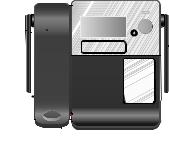
User’s manual
SynJ SB67138
DECT 6.0 4-line corded/cordless small business system
Table of contents |
|
Getting started |
|
Quick reference guide............................... |
1 |
Installation...................................................... |
4 |
Planning your system................................ |
5 |
Telephone base installation................... |
6 |
To connect the corded handset |
|
and power adapter to the |
|
telephone base......................................... |
6 |
To connect the telephone line |
|
cords to the telephone base............. |
7 |
Optional backup battery installation... |
9 |
Expand your telephone system.......... |
10 |
Add and register handsets.................... |
10 |
To register a handset to your |
|
telephone base....................................... |
10 |
Add and register desksets.................... |
11 |
To register a deskset to your |
|
telephone base....................................... |
11 |
Add and register a |
|
cordless headset.................................... |
12 |
To register a cordless headset to |
|
your telephone base .......................... |
12 |
Deregister devices..................................... |
13 |
Add a corded headset............................. |
14 |
To add a corded headset to the |
|
telephone base....................................... |
14 |
Telephone base setup............................. |
15 |
Menu settings.......................................... |
15 |
Ringer volume......................................... |
15 |
Volume control........................................ |
16 |
Ringer tone............................................... |
16 |
Ring group................................................. |
17 |
Do not disturb (DND)........................... |
17 |
LCD contrast............................................. |
18 |
Key tone..................................................... |
18 |
Language.................................................... |
18 |
Line selection........................................... |
19 |
Set line mode.......................................... |
19 |
Area codes................................................ |
20 |
Hold reminder.......................................... |
21 |
Set date and time.................................. |
21 |
Music on hold (M.O.H.)........................ |
22 |
Auto attendant setup (for |
|
answering system)................................ |
27 |
Record announcement |
|
(auto attendant)..................................... |
27 |
Record extension list............................ |
28 |
Number of rings (auto attendant)... |
29 |
Mailbox setup (for |
|
answering system)................................ |
30 |
Number of rings |
|
(general mailbox)................................... |
30 |
Record announcement |
|
(independent mailbox)........................ |
30 |
Select announcement.......................... |
31 |
Mailbox setup (for general mailbox)... |
32 |
Set access code (remote code)...... |
32 |
Call screening.......................................... |
32 |
Notify alert................................................ |
33 |
Remaining space.................................... |
34 |
Mailbox setup (for |
|
handset/deskset)................................... |
35 |
Fast answer mode................................. |
35 |
Handset/deskset |
|
announcement setup........................... |
35 |
Switch to general mailbox................. |
36 |
Speed dial setup........................................ |
37 |
Enter, edit or delete a |
|
speed dial number................................ |
37 |
Customer support.................................. |
37 |
Screen icons, indicator tones |
|
and lights................................................... |
38 |
Telephone base operation |
|
Telephone base basic operation........ |
40 |
Line indicators......................................... |
40 |
Making a call............................................ |
40 |
On hook dialing (predialing)............. |
41 |
Using the speakerphone.................... |
41 |
Calling a speed dial number............ |
41 |
Answering a call..................................... |
42 |
Temporary ringer silencing............... |
42 |
Last number redialing.......................... |
42 |
Options while on calls............................ |
43 |
Volume control........................................ |
43 |
Call waiting............................................... |
43 |
Call privacy............................................... |
44 |
Recording a call...................................... |
44 |
Mute.............................................................. |
45 |
Hold.............................................................. |
46 |
Switching between lines.................... |
46 |
Join a call in progress......................... |
46 |
Chain dialing............................................ |
47 |
Three-way conference calls.............. |
47 |
COVM............................................................... |
49 |
COVM (central office voicemail)..... |
49 |
COVM reset............................................... |
49 |
Intercom......................................................... |
50 |
Make an intercom call to a |
|
cordless handset/deskset ................ |
50 |
Answer an intercom call.................... |
51 |
End an intercom call............................ |
51 |
Make another intercom call while |
|
on an intercom call.............................. |
51 |
Answer an incoming call during |
|
an intercom call..................................... |
51 |
Call transfer.................................................. |
52 |
Blind transfer........................................... |
52 |
Transfer a call and speak to the |
|
receiving party........................................ |
52 |
Answer a transferred call.................. |
53 |
Push to talk (PTT) intercom.................. |
54 |
PTT to a single device......................... |
54 |
PTT to all devices................................... |
54 |
Answer a PTT call.................................. |
55 |
Convert a PTT call to an |
|
intercom call............................................ |
55 |
End a PTT call ........................................ |
55 |
Directory |
|
About the directory.................................. |
56 |
Capacity...................................................... |
56 |
Exit the directory.................................... |
56 |
Create directory entries......................... |
57 |
Create a new directory entry........... |
57 |
Store a pause in a |
|
directory number................................... |
58 |
Store a flash in a |
|
directory number................................... |
58 |
Review directory......................................... |
59 |
Review directory entries..................... |
59 |
Search directory......................................... |
60 |
Search by name...................................... |
60 |
Dial, delete or edit entries.................... |
61 |
Display dial................................................ |
61 |
Delete an entry....................................... |
61 |
Delete all entries.................................... |
61 |
Edit an entry............................................. |
61 |
Caller ID |
|
About caller ID............................................ |
62 |
Information about caller ID with |
|
call waiting............................................... |
62 |
Caller ID Information............................... |
63 |
How the caller ID information |
|
(call log) works....................................... |
63 |
Caller ID operation.................................... |
64 |
Memory match........................................ |
64 |
Missed (new) calls indicator............. |
64 |
Review the caller ID information... |
64 |
View dialing options............................. |
65 |
Dial a call log entry.............................. |
65 |
Delete entries.......................................... |
65 |
Save a call log entry to |
|
the directory............................................. |
66 |
Reasons for missing caller |
|
ID information......................................... |
67 |
Answering system |
|
Answering system and voicemail...... |
68 |
Setting your system to automatically |
|
answer calls.............................................. |
69 |
An example of a 2-line answering |
|
system setup............................................ |
69 |
An example of a 4-line answering |
|
system setup............................................ |
70 |
Select the answer mode.................... |
70 |
Answering system capacity.............. |
70 |
Auto attendant operation...................... |
71 |
Turn the auto attendant on.............. |
71 |
Using the auto attendant................... |
71 |
Using multiple auto attendants...... |
72 |
Auto attendant flow chart................. |
73 |
Answering system operation............... |
74 |
Set general delivery mailbox |
|
to answer................................................... |
74 |
Incoming messages.............................. |
74 |
New message indication.................... |
74 |
Message playback................................. |
74 |
Options during playback.................... |
75 |
Delete all old messages..................... |
75 |
Transfer message................................... |
76 |
Record and deliver memos............... |
77 |
Play back a memo................................. |
78 |
Set general delivery mailbox to |
|
not answer................................................ |
78 |
Disable the answering system........ |
78 |
Remote access............................................ |
79 |
Cordless headset |
|
Cordless headset operation................. |
81 |
Cordless headset |
|
extension number.................................. |
81 |
Switch between corded or cordless |
|
handset, telephone speakerphone |
|
and cordless headset.......................... |
81 |
Appendix |
|
Telephone base display |
|
screen messages.................................... |
82 |
Maintenance................................................. |
85 |
Important safety information............... |
86 |
FCC part 68 and ACTA............................ |
88 |
FCC part 15.................................................. |
89 |
Limited warranty........................................ |
90 |
Technical specifications.......................... |
92 |
Troubleshooting.......................................... |
93 |
Index |
|
Index.............................................................. |
100 |
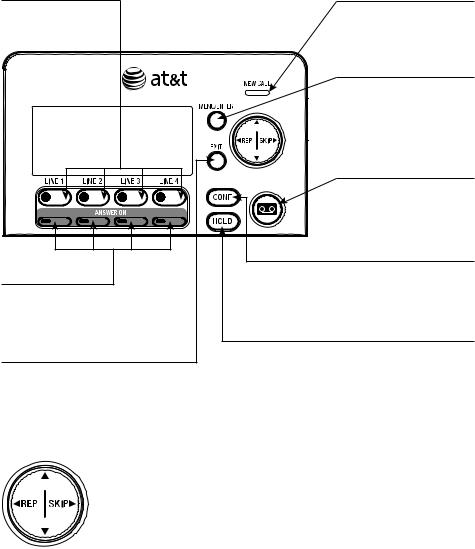
Getting started
Quick reference guide
LINE 1-LINE 4 keys |
NEW CALL indicator |
Press to make or answer a call on the desired line (pages 40-42).
ANSWER ON keys
Press to show the automatic answer options for that line (page 70).
EXIT
While in a menu, press to cancel an operation and exit the menu display.
Navigation keys
On when there are new or missed calls (page 64).
MENU/ENTER
Press to enter the menu.
While in the menu, press to select an item or save an entry or setting.
 (Messages)
(Messages)
When in idle mode, press to enter the general mailbox menu (page 74).
CONF
Press to add another extension or outside line to an existing call (pages 47-48).
HOLD
Press to place an outside call on hold (page 46).
While in menus, press  or
or  to scroll through the menus, highlight items or change settings. Press
to scroll through the menus, highlight items or change settings. Press  REP to return to the previous menu.
REP to return to the previous menu.
While entering names or numbers, press  REP or SKIP
REP or SKIP to move the cursor to the left or right.
to move the cursor to the left or right.
While playing back messages, press  REP once to repeat the message, or press
REP once to repeat the message, or press  REP twice to hear the previous message, or press SKIP
REP twice to hear the previous message, or press SKIP to skip to the next message.
to skip to the next message.
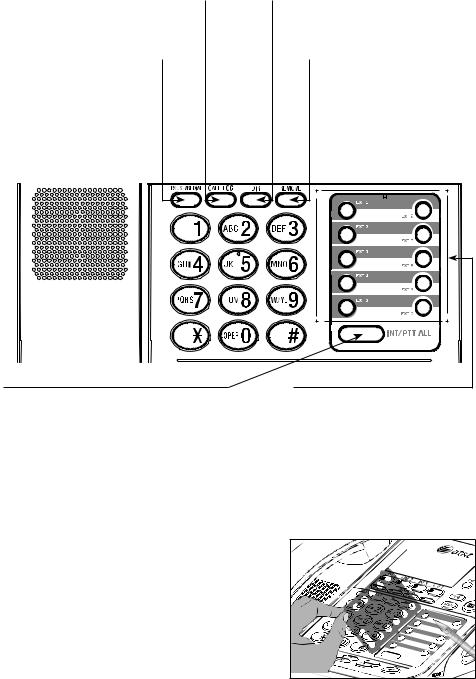
Getting started
Quick reference guide
CALL LOG |
|
|
DIR |
|
Press to view caller ID |
|
|
Press to view directory |
|
information (page 64). |
|
|
information (page 59). |
|
PAUSE/REDIAL |
|
|
|
REMOVE |
Press repeatedly to view the |
|
|
While playing a message, press to |
|
last 10 numbers dialed |
|
|
delete the message (page 75). |
|
(page 42). |
|
|
While reviewing the caller ID |
|
While entering digits, press to |
|
|
information, press to delete an |
|
insert a dialing pause |
|
|
individual entry (page 65). |
|
(page 58). |
|
|
While predialing, press to delete |
|
|
|
|
|
digits (page 41). |
INT/PTT ALL |
One-touch keys, EXT 1-0 |
Press to page all extensions. An intercom |
Press to intercom with the desired |
connection is established with the first extension |
cordless extension number (page 50). |
that answers (page 50). |
Press and hold to broadcast your |
Press and hold to broadcast your voice to all |
voice to that extension (page 54). |
extensions (page 54). |
|
Directory card
To write names on the directory card, follow the steps below:
1.Remove the clear plastic cover by inserting the tip of a small item such as a paperclip into the hole at the top edge of the cover.
2.Pull out the directory card.
3.Write the information on the directory card.
4.Replace the directory card and the plastic cover.
|
EXT1 |
|
EXT2 |
|
EXT3 |
EXT4 |
EXT8 |
|
|
EXT |
EXT9 |
5 |
|
IN |
EXT0 |
|
|
T/PTT ALL |
|
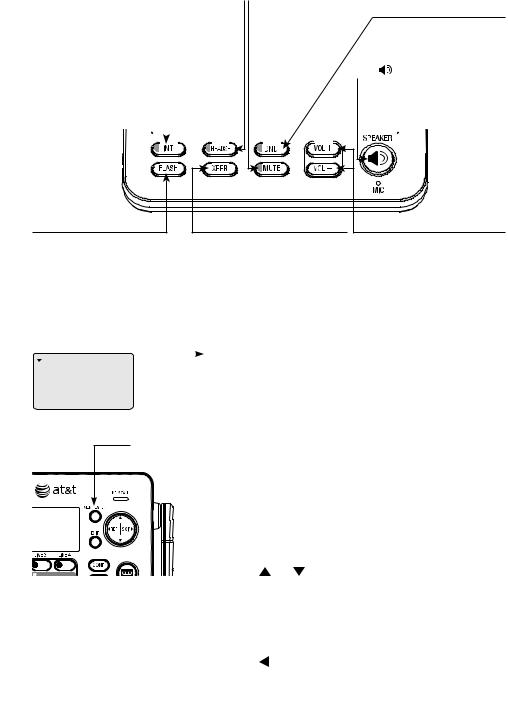
Getting started
Quick reference guide
HEADSET |
|
|
MUTE |
|
DND |
||||||||||
When a corded headset is connected to |
|
|
During a call, press to |
|
(do not disturb) |
||||||||||
the telephone base, press to get a line, |
|
|
mute the microphone |
|
Press twice to turn the |
||||||||||
answer a call or hang up (pages 41-42). |
|
|
(page 45). During an |
|
feature on. Press again to |
||||||||||
The red indicator is on when the headset |
|
|
incoming call, press |
|
turn off (page 17). |
||||||||||
is in use. |
|
|
to mute the ringer |
|
SPEAKER |
||||||||||
INT |
|
|
(page 42). |
|
|||||||||||
|
|
|
|
|
|
|
|
Press to turn on the |
|||||||
|
|
|
|
|
|
|
|
|
|
|
|
|
|
||
When in idle mode, press |
|
|
|
|
|
|
|
|
|
|
|||||
|
|
|
|
|
|
|
|
|
speakerphone. Press again |
||||||
to initiate an intercom |
|
|
|
|
|
|
|
|
|
|
|
||||
|
|
|
|
|
|
|
|
|
to turn it off (page 41). |
||||||
call (page 50). |
|
|
|
|
|
|
|
|
|
|
|
||||
|
|
|
|
|
|
|
|
|
|
|
|||||
|
|
|
|
|
|
|
|
|
|
|
|
|
|
|
|
|
|
|
|
|
|
|
|
|
|
|
|
|
|
|
|
|
|
|
|
|
|
|
|
|
|
|
|
|
|
|
|
|
|
|
|
|
|
|
|
|
|
|
|
|
|
|
|
FLASH |
XFER (transfer) |
VOL+/VOL- |
During a call, press to |
Press to transfer a call to an |
During a call, press to adjust |
answer an incoming call |
extension (page 52). |
the listening volume (page 16). |
when you receive a call |
Press to transfer messages |
During message playback, |
waiting alert (page 43). |
from the general mailbox to a |
press to adjust the playback |
|
handset mailbox (page 76). |
volume (page 75). |
Main menu
The > symbol highlights a menu item.
>Directory
Call log
Ringer setting Mailbox setup
|
|
|
Main menu |
|
|
|
|
|
|
|
• Directory (pages 56-61) |
|
|
|
• Call log (pages 62-66) |
|
|
|
• Ringer setting (pages 15-17) |
|
|
|
• Mailbox setup (pages 30-34) |
Menu |
|
|
• Base setup (pages 18-26) |
|
|
• COVM (page 49) |
|
|
|
||
|
|
|
|
|
|
|
• Speed dial setup (page 37) |
• Customer support (page 37)
• |
Registration (pages 10-13) |
Using menus |
|
• Press MENU/ENTER to show the first menu |
|
|
item, Directory. |
• |
Press or to scroll through menu items. |
• Press MENU/ENTER to select or save changes
|
to a highlighted menu item. |
• |
Press EXIT to cancel an operation, exit the |
|
menu display or return to the idle screen. |
• |
Press REP to back up to the previous menu. |
Getting started
Installation
Install the telephone base close to a telephone jack and a power outlet not controlled by a wall switch. The telephone base should be placed on a flat surface. For optimum range and better reception, place the telephone base in a central and open location.
If you subscribe to high-speed Internet service (DSL - digital subscriber line) through your telephone lines, you must install a DSL filter between each telephone line cord and telephone wall jack (page 7). The filter prevents noise and caller ID problems caused by DSL interference. Please contact your DSL service provider for more information about DSL filters.
Your product may be shipped with a protective sticker covering the telephone base and handset displays - remove them before use.
For customer service or product information, visit our website at www.telephones.att.com or call 1 (888) 915-2007. In Canada, dial 1 (866) 288-4268.
Avoid placing the telephone base too close to:
•Communication devices such as television sets, VCRs, or other cordless telephones.
•Excessive heat sources.
•Noise sources such as a window with traffic outside, motors, microwave ovens, refrigerators, or fluorescent lighting.
•Excessive dust sources such as a workshop or garage.
•Excessive moisture.
•Extremely low temperature.
•Mechanical vibration or shock such as on top of the washing machine or work bench.
Getting started
Planning your system
The SynJ SB67138 package includes one telephone base and one cordless handset (already registered). The included cordless handset has been assigned extension number 1. The system supports a maximum of four external lines, which are provided by your telephone service provider.
You can expand the system by adding a combination of up to 10 additional cordless handsets (AT&T model SynJ SB67108), desksets (AT&T model SynJ SB67148), and one cordless headset (AT&T model TL7600). The system automatically assigns an extension number to each device you add.
You can use a DECT 6.0 repeater (AT&T model SynJ SB67128) to extend the operating range for cordless handsets to cover areas where the signal is very weak or not available.
 NOTES:
NOTES:
1.If you have two or three telephone lines, you will need one two-line adapter for every two lines. If you have four telephone lines, you will need two two-line adapters.
2.If your establishment has four telephone lines from one-line telephone jacks, you will need to purchase a telephone line cord (purchased at an electronics store in your area) or equivalent for each two-line adapter.
3.If you have high-speed Internet service (DSL - digital subscriber line), you need to have an external or internal DSL splitter for each telephone line installed at your location by your DSL provider.
IMPORTANT INFORMATION
For complete instructions on using the accessory cordless handset or headset, please refer to the appropriate manual.
Purchase any desired accessories:
•Cordless handsets (AT&T model SynJ SB67108)
•DECT 6.0 expansion desksets (AT&T model SynJ SB67148)
•Cordless headset (AT&T model TL7600)
•DECT 6.0 repeater (AT&T model SynJ SB67128)
•Additional telephone line cords
To order these accessories or to view the manuals, visit our website at www.telephones.att.com, or call 1 (888) 915-2007. In Canada, dial 1 (866) 288-4268.
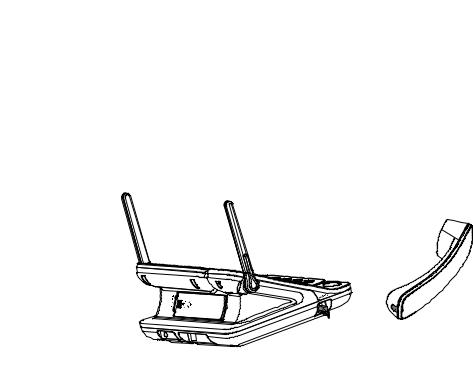
Getting started
Telephone base installation
To connect the corded handset and power adapter to the telephone base
Plug the large end of the power adapter into a power outlet not controlled by a wall switch.
Raise the two antennas for optimum wireless range and performance. For greater range, add optional repeaters (AT&T model SynJ SB67128).
Plug the end of the coiled handset cord into the HANDSET jack on the left side of the telephone.
Plug the small end of the power adapter into the power jack at the bottom of the telephone base. Route the power adapter cord through the slot on the bottom of the telephone.
 NOTE: For complete instructions on installing the cordless handset, see Add and register handsets on page 10 of this user’s manual, refer to the SynJ SB67108 user’s manual. For complete instructions on installing the expansion deskset, see Add and register desksets on page 10 of this user’s manual, refer to the SynJ SB67148 user’s manual. You can visit www.telephones.att.com to download the user’s manuals.
NOTE: For complete instructions on installing the cordless handset, see Add and register handsets on page 10 of this user’s manual, refer to the SynJ SB67108 user’s manual. For complete instructions on installing the expansion deskset, see Add and register desksets on page 10 of this user’s manual, refer to the SynJ SB67148 user’s manual. You can visit www.telephones.att.com to download the user’s manuals.
IMPORTANT INFORMATION
1.Use only the power adapter supplied with this product. To order a replacement power adapter, visit
our website at www.telephones.att.com, or call 1 (888) 915-2007. In Canada, dial 1 (866) 288-4268.
2.The power adapter is intended to be correctly oriented in a vertical or floor mount position. The prongs are not designed to hold the plug in place if it is plugged into a ceiling, under-the-table or cabinet outlet.

Getting started
Telephone base installation
To connect the telephone line cords to the telephone base
If you subscribe to high-speed Internet service (DSL - digital subscriber line) through your telephone lines, you must install a DSL filter between each telephone line cord and telephone wall jack. The filter prevents noise and caller ID problems caused by DSL interference. Please contact your DSL service provider for more information about DSL filters.
Install the telephone line cords as shown below:
Line 3 + Line 4
Electrical outlet not controlled by a wall switch
Telephone
 line cords Power adapter
line cords Power adapter 
Line 1 + Line 2
If you have DSL high-speed Internet service, a DSL filter (not included) is required on each DSL line.
L3/L4 |
L1/L2 |
L3/L4 |
L1/L2 |
Option 1: To connect two 2-line wall jacks
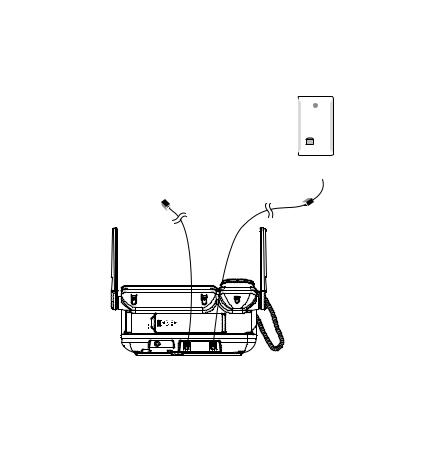
Getting started
Telephone base installation
Line 4 |
Line 3 |
Line 2 |
Line 1 |
Electrical outlet |
|
|
|
not controlled |
|
|
|
by a wall switch |
|
|
|
 Two-line adapters
Two-line adapters
Power adapter
 If you have DSL high-speed Internet service, a DSL filter (not included) is required on each DSL line.
If you have DSL high-speed Internet service, a DSL filter (not included) is required on each DSL line.
L3/L4 |
L1/L2 |
L3/L4 |
L1/L2 |
Option 2: To connect four one-line wall jacks
 NOTES:
NOTES:
1.If you have three one-line wall jacks, you need a two-line adapter for two of the lines.
2.The long cords supplied with the telephone are four-conductor cords.
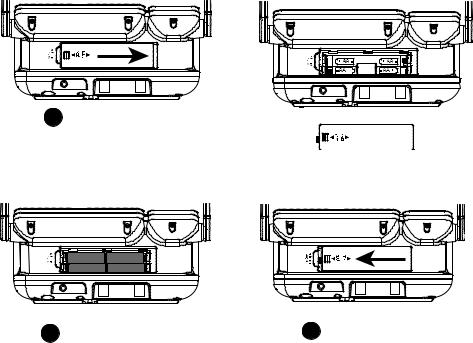
Getting started
Optional backup battery installation
In the event of a power failure, if four AA batteries (purchased separately) are installed in the telephone, your telephone base can still operate. All lines will work.
If power fails during a call on the telephone base, the call continues until you hang up. If power fails during a call on a handset, you can still make and answer calls. During a power failure, although the screen backlight is off, you can still make and answer calls. If the power resumes while you are on a call, the call continues.
Install the batteries as shown below:
Step 1 Open the backup battery compartment
cover.
Step 2 |
Place the batteries |
|
in the compartment |
|
following the polarity |
|
label +/-. |
Step 3 |
Align the cover flat |
|
against the battery |
|
compartment, then |
|
slide it to the left |
|
until it clicks into |
|
place to lock the |
|
cover. |
 NOTE: Use disposable AA alkaline batteries only. Do not use rechargeable batteries.
NOTE: Use disposable AA alkaline batteries only. Do not use rechargeable batteries.
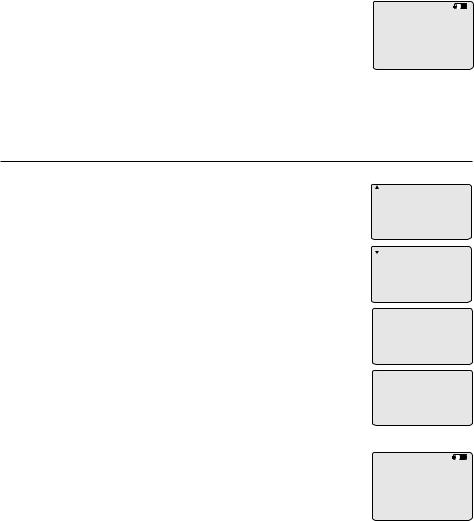
Getting started
Expand your telephone system
Your telephone can support a maximum of 10 handsets/desksets, or 9 handsets/ desksets and one cordless headset. You can add handsets, desksets, and one headset (AT&T models SynJ SB67108, SynJ SB67148 and TL7600, sold separately) to the SynJ SB67138 at any time, but each new handset/deskset or headset must be registered to the telephone base before use. You must register each handset, deskset and headset separately.
Add and register handsets
The handset provided with your SynJ SB67138 is already registered as Handset 1. Additional handsets are assigned
numbers in the order they are registered (Handset 2 to
Handset 10).
If the handset does not have enough power to proceed with
the registration, you need to charge the new handset for at least five minutes (see Battery installation and charging in the SynJ SB67108 cordless handset manual). Start registration when the handset screen shows Press MENU on BS, sel Registration & sel Register HS. Then put HS in cradle.
To register a handset to your telephone base
1. Make sure the handset is out of the charger and the |
SB67138: |
|
screen shows Press MENU on BS, sel Registration & |
COVM |
|
sel Register HS. Then put HS in cradle. before you |
||
Speed dial setup |
||
begin registration. |
||
Customer support |
> Registration
2. On the telephone base, press MENU/ENTER.
3.Scroll down to Registration and press MENU/ENTER.
4.Press MENU/ENTER again to select Register HS.
>Register HS Deregistration
5.Place the unregistered handset into the charger. The telephone base screen shows Registering new device... It takes up to 60 seconds to complete the
registration. There is a beep sound when the registration is successful. The telephone base shows Handset registered and then the handset shows X:Handset X
(X represents the extension number [1-0]; Handset X represents the handset name).
 NOTES:
NOTES:
1.If the registration is not successful, the telephone base screen displays Registration failed with an error tone. To reset the handset, remove the
handset from the cradle. Try the registration process again.
Registering
new device...
Handset registered
SB67148:
2:Handset 2
Set date & time
Charging
2.Make sure to remove all unregistered system handsets or cordless headset from the cradles before registering a new handset.
10
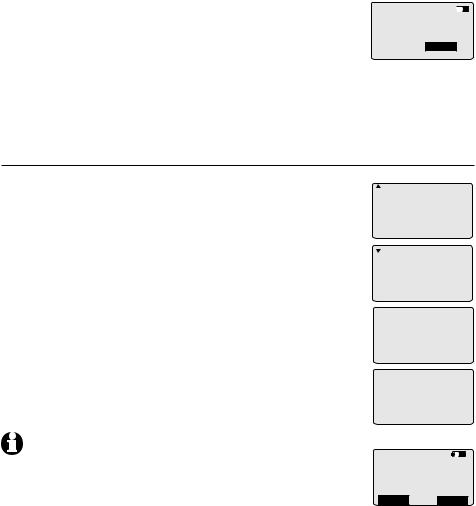
Getting started
Add and register desksets
The handset provided with your SynJ SB67138 is already registered as Handset 1. Additional desksets are assigned numbers in the order they are registered (Deskset 2 to Deskset 10). 
Start registration when the handset screen shows Press
MENU on MAIN base, select Registration & then Register HS. Then press Start.
To register a deskset to your telephone base
1. The SynJ SB67148 deskset shows Press MENU on Main base, select Registration & then Register HS. Then press Start. before you begin registration.
2. On the main telephone base, press MENU/ENTER.
3. Scroll down to Registration and press MENU/ENTER.
4. Press MENU/ENTER again to select Register HS.
5. Press the Start softkey on the unregistered deskset. The telephone base screen shows Registering new device...
It takes up to 60 seconds to complete the registration. You hear a beep when the registration is successful. The telephone base shows Deskset registered and the deskset shows X:Deskset X (X represents the extension number [1-0]; Deskset X represents the deskset name).
NOTE: If the registration is not successful, the telephone base screen displays Registration failed with an error tone. Try the registration process again.
11
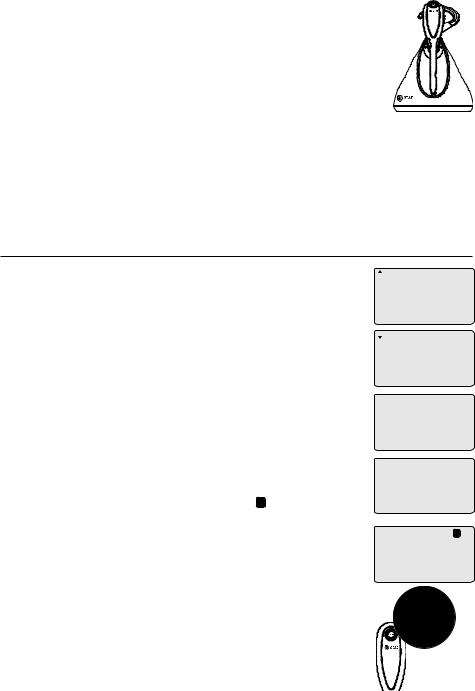
Getting started
Add and register a cordless headset
You can use this phone handsfree when you register a DECT 6.0 cordless headset (AT&T model TL7600, sold separately)
to the telephone base. You can only register one cordless headset to the telephone base. The cordless headset must have a charged battery. Make sure the headset battery is properly installed.
Place the headset in the headset charger and note the color of the ON/OFF button. If the button flashes a blue and
orange light twice every five seconds, the headset is unregistered. If the button shows a constant blue light, the headset is registered. You need to deregister the headset before you can register it to the SynJ SB67138. See the deregistration instructions in the user’s manual of the telephone to which it is currently registered. See page 81 for instructions on using the cordless headset with this telephone.
To register a cordless headset to your telephone base
1. |
Place the headset in the headset charger and allow |
|
it to charge for at least five minutes before beginning |
|
registration. Make sure the headset is out of the headset |
|
charger before you begin registration. |
2. |
On the telephone base, press MENU/ENTER. |
3. |
Scroll down to Registration and press MENU/ENTER. |
4. |
Press MENU/ENTER again to select Register HS. The |
|
telephone base shows Registering new device... It takes |
|
up to 60 seconds to complete the registration. |
5.Place the headset into the cradle. The telephone base shows Cordless headset registered and beeps when the registration is successful.
COVM
Speed dial setup Customer support
>Registration
>Register HS Deregistration
Registering
new device...
Cordless headset
6.Lift the headset, then press the headset ON/OFF button. If registered you hear a dial tone and the extension 0 icon appears on
the telephone base, the registration was successful.
If there is no dial tone, or the ON/OFF light on the headset flashes twice every five seconds, the registration was not successful. Remove the headset from the headset charger and repeat the registration process again, starting with Step 2 above.
If you have a dial tone but an extension number other than 0 displays on the telephone base, the headset is registered as a handset and will not function properly. If this is the case, you must deregister and start over. See Deregister devices on the next page.
0
Line1 00:00:05
12
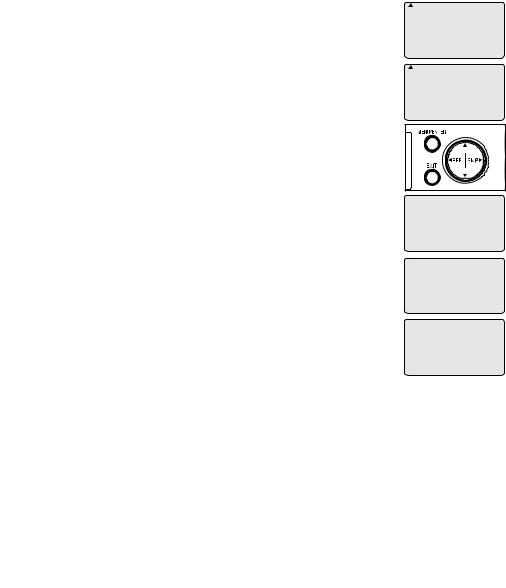
Getting started
Deregister devices
If you already have 10 registered devices and need to replace or add a new device, or if you wish to change the assigned extension numbers of your devices, you must first deregister all devices. You need to register each device you wish to use again. Deregistering a cordless handset or
deskset does not remove the data saved on that device. Please read all the instructions on this page before beginning the deregistration process.
Please make sure the telephone system is not in use before deregistration. To deregister all devices registered to the telephone base:
1.On the telephone base, press MENU/ENTER.
2.Scroll down to Registration and press MENU/ENTER.
3.Scroll down to Deregistration and press MENU/ENTER.
COVM
Speed dial setup Customer support
>Registration
Register HS >Deregistration
4. The telephone base screen shows Deregister all devices? <=No >=Yes. Press  REP to exit or press SKIP
REP to exit or press SKIP to continue the deregistration.
to continue the deregistration.
5.If you press SKIP , The telephone base shows Deregistering. It takes up to 10 seconds to complete the deregistration. The telephone base shows All devices deregistered and beeps when the deregistration is successful.
, The telephone base shows Deregistering. It takes up to 10 seconds to complete the deregistration. The telephone base shows All devices deregistered and beeps when the deregistration is successful.
Deregister all devices?
<=No >=Yes
Deregistering
All devices deregistered
 NOTES:
NOTES:
1.If the deregistration process is not successful, you might need to reset the system and try again. To reset, you can press EXIT on the telephone base. You can also reset the telephone base by unplugging the power from the telephone base and plugging it back in.
2.To register a cordless handset again, refer to the registration information on page 10.
3.To register an expansion deskset again, refer to the registration information on page 11.
4.To register a cordless headset again, refer to the registration information on page 12.
13

Getting started
Add a corded headset
You can use this telephone handsfree when you install any industry-standard 2.5mm corded telephone headset (purchased separately). For best results,
use an AT&T 2.5mm corded headset. To purchase a headset, visit our website at www.telephones.att.com, or call 1 (888) 915-2007. In Canada, dial 1 (866) 288-4268. See page 41 for instructions on using the corded
headset with this telephone.
To add a corded headset to the telephone base
|
IN |
|
|
T/P |
|
|
TT |
ALL |
|
T |
|
HEADSE |
|
|
/AUX |
IN |
|
HEADSET / AUX IN
Plug a 2.5 mm headset into the HEADSET/AUX IN jack on the side of the telephone base.
Side view of the telephone base
 NOTE: If you have corded and cordless headsets connected to your telephone base, the HEADSET button only controls the corded headset.
NOTE: If you have corded and cordless headsets connected to your telephone base, the HEADSET button only controls the corded headset.
14
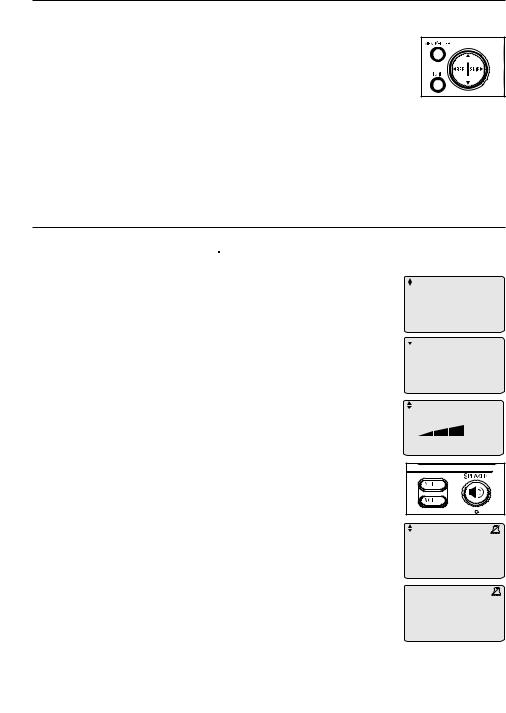
Getting started
Telephone base setup
Menu settings
Use this feature to use the menus to change the telephone base settings.
1. Press MENU/ENTER when in idle mode (when the telephone
is not in use) to enter the main menu.
2. Press  or
or  to scroll to the feature to be changed. The > symbol indicates the selected menu item.
to scroll to the feature to be changed. The > symbol indicates the selected menu item.
3.Press MENU/ENTER to select the menu item.
4.Press EXIT to exit setup without making changes.
 NOTE: Press EXIT to cancel an operation, exit the menu display, or return to idle mode.
NOTE: Press EXIT to cancel an operation, exit the menu display, or return to idle mode.
Ringer volume
Use this feature to set the ringer volume to one of three levels or turn the ringer off. When the ringer is off, the  icon appears on the telephone base screen.
icon appears on the telephone base screen.
1.When the telephone is idle, press MENU/ENTER.
2.Press  or
or  to scroll to Ringer setting. Press MENU/ENTER.
to scroll to Ringer setting. Press MENU/ENTER.
3.Press MENU/ENTER again to select Ringer volume.
4.Press  ,
,  , VOL+ or VOL- on the telephone base to adjust the ringer volume.
, VOL+ or VOL- on the telephone base to adjust the ringer volume.
5.Press MENU/ENTER to save the setting and return to the previous menu. There is a confirmation tone. To exit without making changes, press EXIT.
 NOTE: The ringer volume also determines the ringer volume for intercom calls (page 50). If the telephone base ringer volume is set to off, that telephone base is silenced for all incoming calls, including intercom calls.
NOTE: The ringer volume also determines the ringer volume for intercom calls (page 50). If the telephone base ringer volume is set to off, that telephone base is silenced for all incoming calls, including intercom calls.
Directory
Call log
>Ringer setting Mailbox setup
>Ringer volume Ringer tone Ringer group
Ringer volume
ENTER=Save
Ringer volume
ENTER=Save
*: Base
0 missed calls
5:12PM 4/27
15
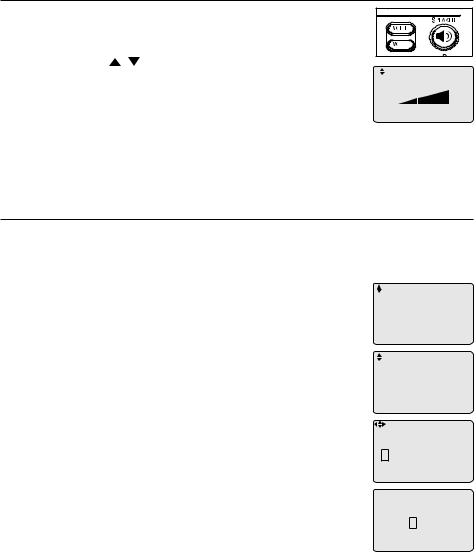
Getting started
Telephone base setup
Volume control |
|
Use this feature to independently set the listening volume |
|
to one of five levels for each of the three listening options |
|
(corded handset, speakerphone and corded headset). While |
|
using each, press , , VOL+ or VOL- to adjust the |
|
listening volume. |
Volume |
|
While adjusting the volume on the corded handset or the corded headset, you hear a triple beep when you reach the
minimum or maximum volume setting.
The SynJ SB67138 telephone base stores the volume setting for each listening option.
Ringer tone
Use this feature to choose one of the seven ringer tones for incoming calls. You can choose different ringer tones for different lines so you can easily identify which line is ringing.
1.When the telephone is idle, press MENU/ENTER.
2.Press  or
or  to scroll to Ringer setting. Press MENU/ENTER.
to scroll to Ringer setting. Press MENU/ENTER.
3.Press  or
or  to scroll to Ringer tone. Press MENU/ENTER.
to scroll to Ringer tone. Press MENU/ENTER.
4.Press  REP or SKIP
REP or SKIP to select the desired line (L1, L2,
to select the desired line (L1, L2,
L3 or L4).
5.Press  or
or  to select a desired ringer tone.
to select a desired ringer tone.
6.Repeat steps 4-5 above to choose ringer tones for other lines if desired.
7.Press MENU/ENTER to save the setting and return to the previous menu. There is a confirmation tone. To exit without making changes, press EXIT.
 NOTE: If you turn off the ringer volume, you will not hear ringer tone samples.
NOTE: If you turn off the ringer volume, you will not hear ringer tone samples.
Directory
Call log
>Ringer setting
Mailbox setup
Ringer volume
>Ringer tone Ringer group
Ringer tone |
|
|||||
L1 |
L2 |
L3 |
L4 |
|||
|
1 |
|
1 |
1 |
1 |
|
Ringer tone |
|
|||||
L1 |
L2 |
L3 |
L4 |
|||
1 |
|
3 |
1 |
1 |
||
16
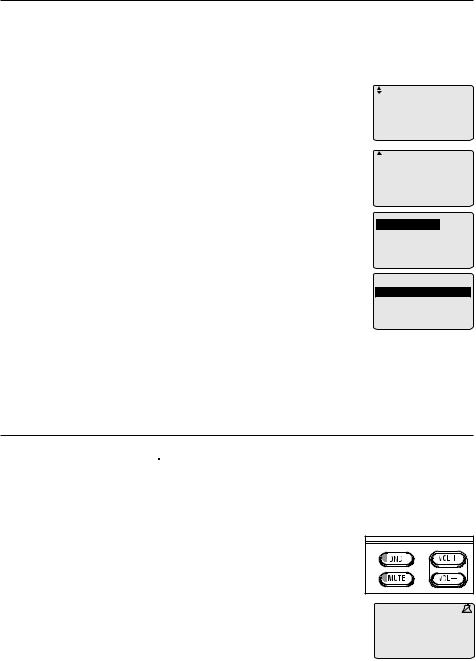
Getting started
Telephone base setup
Ring group
Use this feature to specify which extensions receive incoming calls. By default, all extensions and the telephone base receive incoming calls. You can block some extensions from receiving calls, however, they can still be used to make outgoing calls.
1.When the telephone is idle, press MENU/ENTER.
2.Press  or
or  to scroll to Ringer setting. Press
to scroll to Ringer setting. Press
MENU/ENTER.
3.Press  or
or  to scroll to Ring group. Press MENU/
to scroll to Ring group. Press MENU/
ENTER.
4.Press  REP or SKIP
REP or SKIP to select a desired line (L1, L2, L3 or L4) while Ring group flashes.
to select a desired line (L1, L2, L3 or L4) while Ring group flashes.
5.Press  or
or  to scroll to Extension number:, use the dial pad to press the number of the extension
to scroll to Extension number:, use the dial pad to press the number of the extension
(*,1,2,3,4,5,6,7,8,9,0) that you want to delete, or press the number again to add it back to the ring group.
6.Press MENU/ENTER to save the setting and return to the previous menu. There is a confirmation tone. To exit without making changes, press EXIT.
Directory
Call log
>Ringer setting
Mailbox setup
Ringer volume Ringer tone
>Ring group
Ring group: L3
Extension number:
*1234567890
<>
Ring group: L3
Extension number: *1-3-56-8-0
ENTER =Save
 NOTE: The symbol * represents the telephone base; 0 represents extension 10.
NOTE: The symbol * represents the telephone base; 0 represents extension 10.
Do not disturb (DND)
Use this feature to silence your telephone base. When you activate the do not disturb function, the  icon appears on the telephone base screen and you will not hear paging tones, voice paging or incoming call rings.
icon appears on the telephone base screen and you will not hear paging tones, voice paging or incoming call rings.
Instead, the LINE 1-LINE 4 indicator flashes to signal an incoming call. If you receive an intercom call, the extension number of that intercom call appears on the screen display.
1.Press DND twice to prevent interruptions. The DND indicator turns on.
2.Press DND again to resume normal call alerts. The DND indicator turns off.
*: Base
0 missed calls 5:12PM 4/27
17
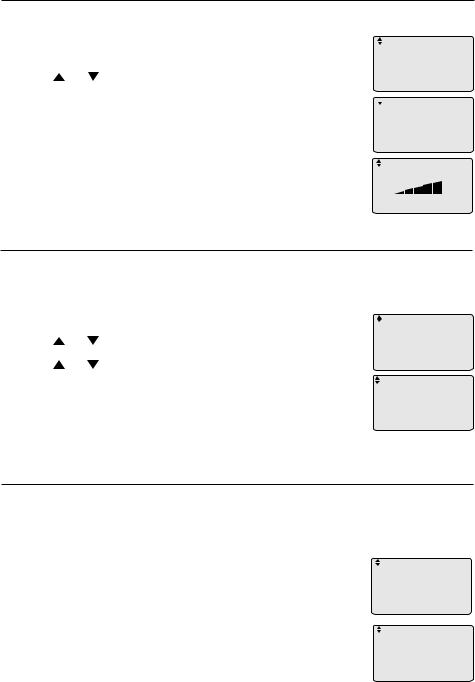
Getting started
Telephone base setup
LCD contrast
Use this feature to adjust the screen contrast to one of six levels to optimize readability in different lighting conditions.
1. |
When the telephone is idle, press MENU/ENTER. |
Call log |
|
Ringer setting |
|||
|
|
||
2. |
Press or to scroll to Base setup, press MENU/ENTER. |
Mailbox setup |
|
|
|
> Base setup |
3.Press MENU/ENTER again to select LCD contrast.
4.Press  or
or  to adjust the screen contrast level. The screen display temporarily fades away as you press
to adjust the screen contrast level. The screen display temporarily fades away as you press  and reappears as you press
and reappears as you press  .
.
>LCD contrast
Key tone
Language
Line selection
5.Press MENU/ENTER to save the setting and return to the previous menu. There is a confirmation tone. To exit, press EXIT.
Key tone
LCD contrast
ENTER=Save
Use this feature to turn the key tone on and off. The telephone base is factory set to beep with each key press. You can turn off this beep sound by turning the key tone off.
1. |
When the telephone is idle, press MENU/ENTER. |
LCD contrast |
||
|
|
|
|
|
2. |
Press |
or |
to scroll to Base setup. Press MENU/ENTER. > Key tone |
|
|
|
|
|
Language |
3. |
Press |
or |
to scroll to Key tone. Press MENU/ENTER. |
Line selection |
|
||||
4.Press  or
or  to scroll to On or Off.
to scroll to On or Off.
5.Press MENU/ENTER to save the setting and return to the previous menu. There is a confirmation tone. To exit without making changes, press EXIT.
Language
Key tone
:Off
ENTER=Save
Use this feature to change the display language that is used in all menus and screen displays. Set the display language on the telephone base and each extension separately. This telephone comes factory set for English displays.
1.When the telephone is idle, press MENU/ENTER.
2.Press  or
or  to scroll to Base setup. Press MENU/ENTER.
to scroll to Base setup. Press MENU/ENTER.
3.Press  or
or  to scroll to Language. Press MENU/ENTER.
to scroll to Language. Press MENU/ENTER.
LCD contrast Key tone
>Language
Line selection
4.Press  or
or  to select English or Español.
to select English or Español.
5.Press MENU/ENTER again to save the setting and return to the previous menu. There is a confirmation tone.
To exit without making changes, press EXIT.
Language
:English
ENTER=Save
18
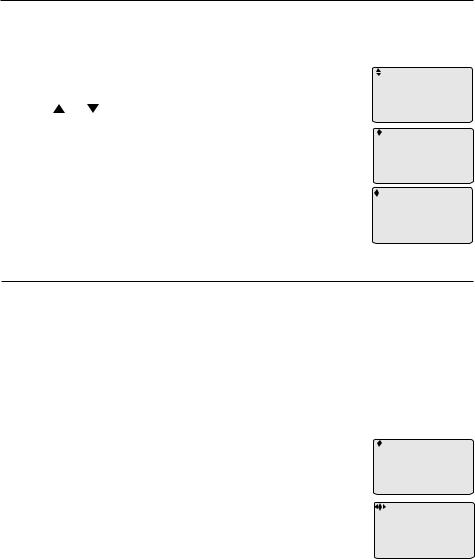
Getting started
Telephone base setup
Line selection
Use this feature to select the default telephone line to be used when you make outgoing calls. This telephone comes factory set for Auto selectable line, which chooses the first available line for making a call. To select a particular line, choose Line 1, Line 2, Line 3 or Line 4.
1. |
When the telephone is idle, press MENU/ENTER. |
Call log |
|
Ringer setting |
|||
|
|
||
2. |
Press or to scroll to Base setup. Press MENU/ENTER. |
Mailbox setup |
|
|
|
> Base setup |
3.Press  or
or  to scroll to Line selection. Press MENU/ENTER.
to scroll to Line selection. Press MENU/ENTER.
4.Press  or
or  to select Auto, Line 1, Line 2, Line 3 or Line 4.
to select Auto, Line 1, Line 2, Line 3 or Line 4.
5.Press MENU/ENTER to save the setting and return to the previous menu. There is a confirmation tone. To exit without making changes, press EXIT.
LCD contrast
Key tone
Language
>Line selection
Line selection :Auto
ENTER=Save
Set line mode
Use this feature to individually select the line mode for each available telephone line. For the system to behave properly, it needs to be set for:
a)PBX lines, which are typical business telephone systems that require you to dial 8 or 9 to get an outside line.
-OR-
b) CO lines, which are standard residential telephone lines. This telephone comes factory set for PBX lines.
1.When the telephone is idle, press MENU/ENTER.
2.Press  or
or  to scroll to Base setup. Press MENU/ENTER.
to scroll to Base setup. Press MENU/ENTER.
3.Press  or
or  to scroll to Set line mode. Press MENU/ENTER.
to scroll to Set line mode. Press MENU/ENTER.
4.Press  or
or  to scroll to a desired line (L1, L2, L3 or L4).
to scroll to a desired line (L1, L2, L3 or L4).
5.Press  REP or SKIP
REP or SKIP to select PBX or CO.
to select PBX or CO.
6.Repeat Steps 4 and 5 to choose the line mode for other lines if desired.
Key tone Language
Line selection >Set line mode
L1 |
CO |
L2 |
PBX |
L3 |
CO |
L4 |
PBX |
7.Press MENU/ENTER to save the setting and return to the previous menu. There is a confirmation tone. To exit without making changes, press EXIT.
19
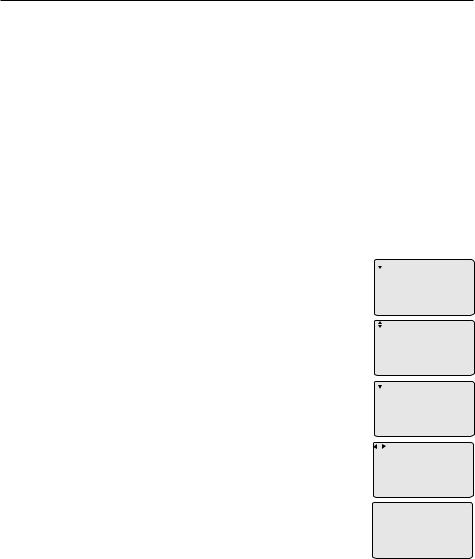
Getting started
Telephone base setup
Area codes
Use this feature to program this system to recognize one home area code and up to four local area codes. This feature makes it easy for you to place a call from the caller ID log.
If you dial seven digits to make a local call (no area code required), enter your area code into the telephone as the home area code. When you receive a call from within your home area code, the caller ID information only displays the seven digits of the telephone number, and when you dial from the call log, only seven digits are dialed.
If you must dial 10 digits (the area code and telephone number) for local calls, enter 000 for the home area code and enter your area code as a local area code. Then, if you receive a call from within your area code, the screen displays all 10 digits of the telephone number, and when you dial from the call log, all 10 digits are dialed.
If you have more than one area code for your region, enter those area codes as local area codes. 
1.When the telephone is idle, press MENU/ENTER.
2.Press  or
or  to scroll to Base setup. Press MENU/ENTER.
to scroll to Base setup. Press MENU/ENTER.
3.Press  or
or  to scroll to Area codes. Press MENU/ENTER.
to scroll to Area codes. Press MENU/ENTER.
4.Press  or
or  to scroll to Home area or Local area 1-
to scroll to Home area or Local area 1-
Local area 4. Press MENU/ENTER to edit it.
5.Use the dial pad keys to enter a three-digit area code. Enter 000 for your home area code if you always dial ten-digit numbers. Press  REP or SKIP
REP or SKIP to scroll to the digit you want to edit, or press REMOVE once to delete a digit; press and hold REMOVE to delete
to scroll to the digit you want to edit, or press REMOVE once to delete a digit; press and hold REMOVE to delete
all digits.
Call log
Ringer setting
Mailbox setup
>Base setup
Language
Line selection
Set line mode
>Area codes
>Home area Local area 1 Local area 2 Local area 3
Enter code: 000 

6.Press MENU/ENTER to save the setting and return to the previous menu. There is a confirmation tone. To exit without making changes, press EXIT.
ENTER=Save
Home area: 000
20
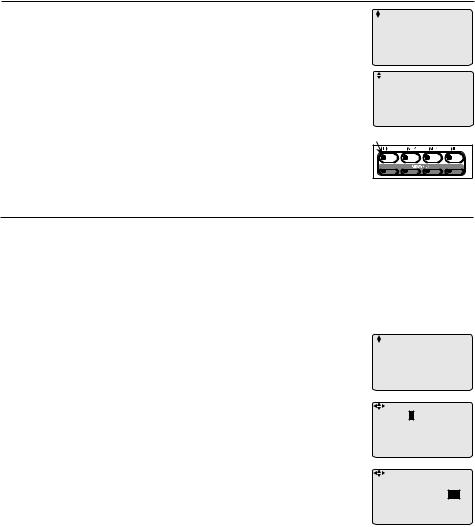
Getting started
Telephone base setup
Hold reminder
When there is a call on hold for more than three minutes, the telephone base gives you a reminder beep once every 30 seconds. You can also turn this setting off.
1.When the telephone is idle, press MENU/ENTER.
2.Press  or
or  to scroll to Base setup. Press MENU/ENTER.
to scroll to Base setup. Press MENU/ENTER.
3.Press  or
or  to scroll to Hold reminder. Press MENU/ENTER.
to scroll to Hold reminder. Press MENU/ENTER.
4.Press  or
or  to scroll to On or Off.
to scroll to On or Off.
5.Press MENU/ENTER to save the setting and return to the previous menu. There is a confirmation tone. To exit without making changes, press EXIT.
Set date and time
Line selection Set line mode Area codes
>Hold reminder
Hold reminder :On
ENTER=Save
Flashing
The answering system displays the date and time of the message while playing messages. Before using the answering system, set the date and time as follows. If you subscribe to caller ID service, the day, month and time are set automatically with each incoming call. The year must be set so that the day of the week can be calculated from the caller ID information.
Follow the steps below to set the month, day, year and time:
1.When the telephone is idle, press MENU/ENTER.
2.Press  or
or  to scroll to Base setup. Press MENU/ENTER.
to scroll to Base setup. Press MENU/ENTER.
3.Press  or
or  to scroll to Date and time. Press MENU/ENTER.
to scroll to Date and time. Press MENU/ENTER.
4.Using the dial pad to enter the date. Press  REP or SKIP
REP or SKIP to scroll to the item you want to edit, and press the dial pad keys to enter the correct digit.
to scroll to the item you want to edit, and press the dial pad keys to enter the correct digit.
Set line mode
Area codes
Hold reminder >Date and time
Date: 12.31. 2006
Time: 09:00 AM
^v=PM
ENTER=Save
5.Press  to move to the time editing.
to move to the time editing.
6.Press  or
or  to select AM or PM.
to select AM or PM.
7.Press  REP or SKIP
REP or SKIP to scroll to the item you want to edit, and press the dial pad to enter the correct digit.
to scroll to the item you want to edit, and press the dial pad to enter the correct digit.
Date: 01.01. 2009
Time: 12:00 PM
^v=AM
ENTER=Save
8.Press MENU/ENTER to save the setting and return to the previous menu. There is a confirmation tone. To exit without making changes, press EXIT.
 NOTES:
NOTES:
1.The time is in a 12-hour clock format. If you set an invalid time, you will hear an error tone while pressing MENU/ENTER to save the setting. The error tone means the setting cannot be saved. You need to correct the time entry to continue the setup process.
2.If the date and time are not set when a message is recorded, the system does not display date and time on the screen while playing messages.
21
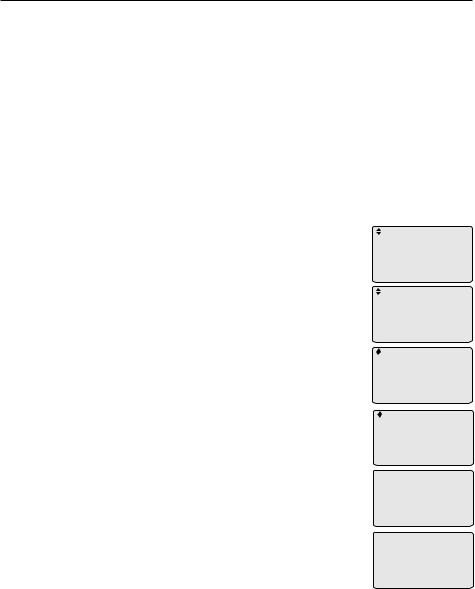
Getting started
Telephone base setup
Music on hold (M.O.H.)
You can choose what callers hear when placed on hold. M.O.H. is set to on by default.
You have four options:
•If you want callers you place on hold to hear nothing, turn M.O.H. off.
•If you want callers on hold to hear the default music that comes with the telephone, turn M.O.H. on but do not record your own music or voice message.
•If you want callers on hold to hear audio that you record onto the telephone, see the instructions on pages 24-25.
•If you want callers to hear audio directly streamed into the telephone, connect an audio source such as a computer, MP3 player or radio to the telephone base (page 26).
Turn M.O.H. on or off:
1.When the telephone is idle, press MENU/ENTER.
2.Press  or
or  to scroll to Base setup. Press MENU/ENTER.
to scroll to Base setup. Press MENU/ENTER.
3.Press  or
or  to scroll to Music on hold. Press MENU/ENTER.
to scroll to Music on hold. Press MENU/ENTER.
4.Press MENU/ENTER again to select M.O.H. on/off.
5.Press  or
or  to highlight On or Off.
to highlight On or Off.
6.If you select On and the source is Recorded M.O.H., when you press MENU/ENTER to save the setting,
Music on hold: On displays.
-OR-
If you select On and the source is Aux In Device with an audio device connected, when you press MENU/ENTER to save the setting, Device connected to the headset jack will be used for M.O.H. displays.
The screen returns to the previous menu. To exit without making changes, press EXIT.
 NOTE: If M.O.H. is turned on, you cannot make any changes to M.O.H. settings while a call is currently on hold. The screen displays M.O.H. currently in use. Please try again later.
NOTE: If M.O.H. is turned on, you cannot make any changes to M.O.H. settings while a call is currently on hold. The screen displays M.O.H. currently in use. Please try again later.
Call log Ringer setting Mailbox setup
>Base setup
Area codes Hold reminder
Date and time
>Music on hold
>M.O.H. on/off
Review M.O.H. Record new M.O.H.
M.O.H. source
Music on hold :On
ENTER=Save
Device connected to the headset jack will be used for M.O.H.
No Device is connected to the headset jack at base.
22
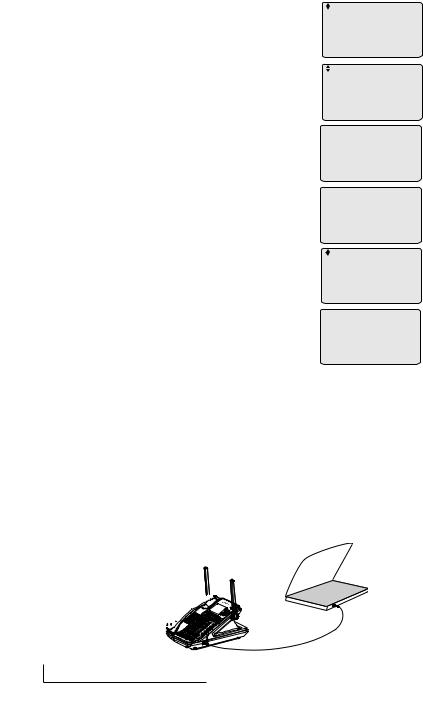
Getting started
Telephone base setup
Listen to the music on hold:
1.When the telephone is idle, press MENU/ENTER.
2.Press  or
or  to scroll to Base setup. Press MENU/ENTER.
to scroll to Base setup. Press MENU/ENTER.
3.Press  or
or  to scroll to Music on hold. Press MENU/ENTER.
to scroll to Music on hold. Press MENU/ENTER.
4.Press  or
or  to scroll to Review M.O.H. Press MENU/ENTER.
to scroll to Review M.O.H. Press MENU/ENTER.
5.Press  or
or  to highlight Recorded M.O.H. or Aux In Device.
to highlight Recorded M.O.H. or Aux In Device.
If you select Recorded M.O.H., press MENU/ENTER to hear the current recording or the default music.
-OR-
If you select Aux In Device, press MENU/ENTER to hear the current music playing on your audio device that is connected to the telephone base.
-OR-
If you select Aux In Device but there is no audio
device connected with the telephone base, No Device is connected to the headset jack at base displays on the screen. Connect an audio device to the HEADSET/AUX IN jack (as shown below), then choose Review M.O.H.
6. Press  REP to return to the previous menu.
REP to return to the previous menu.
Change the music on hold volume:
M.O.H. on/off
>Review M.O.H.
Record new M.O.H.
M.O.H. source
>Recorded M.O.H.
Aux In Device
Play M.O.H.
01:42
<=Back
Aux In Device playing
<=Back
Recorded M.O.H.
> Aux In Device
No Device is connected to the headset jack at base.
The music on hold volume can only be changed at the audio device.
1.Place a call to your SynJ SB67138.
2.Press HOLD on the SynJ SB67138 to place the call on hold. Listen to the music on hold to determine if the volume is desirable.
3.If you are using recorded audio and want to make adjustments to the volume on the audio device and record the audio again, start again with Step 1 of
Change the music on hold volume.
-OR-
If you get streaming audio from a device and want to make adjustments to the volume, change the volume on the audio device while the call is on hold until you find the desired volume. When you finish listening to the audio, hang up both telephones.
TALL
23

Getting started
Telephone base setup
Record music or a voice message
You can record audio or music from an audio source such as a computer, MP3 player, or stereo using the audio cable provided. The recording can be up to three minutes long and plays repeatedly while a call is on hold.
M.O.H. on/off Review M.O.H.
>Record new M.O.H. M.O.H. source
 NOTE: It is the user’s responsibility to comply with the copyright laws and to provide lawfully acquired music for the music on hold feature. Unlawful use of copyright protected music and/or lyrics may subject the user to fines and other legal action.
NOTE: It is the user’s responsibility to comply with the copyright laws and to provide lawfully acquired music for the music on hold feature. Unlawful use of copyright protected music and/or lyrics may subject the user to fines and other legal action.
Record music or a message using an audio device:
1.When the telephone is idle, press MENU/ENTER.
2.Press  or
or  to scroll to Base setup. Press MENU/ENTER.
to scroll to Base setup. Press MENU/ENTER.
3.Press  or
or  to scroll to Music on hold. Press MENU/ENTER.
to scroll to Music on hold. Press MENU/ENTER.
4.Press  or
or  to scroll to Record new M.O.H. Press MENU/ENTER.
to scroll to Record new M.O.H. Press MENU/ENTER.
5.Plug the small end (2.5mm plug) of the audio cable into the HEADSET/AUX IN jack on the telephone base and plug the large end (3.5mm plug) of the audio cable into the audio output jack on your audio device (as shown on the previous page).
M.O.H. record
ENTER=Start
6. When your audio device is ready to play, press MENU/ENTER
on the telephone. You hear the voice prompt “Record after ENTER=Stop the tone. Press stop when you are done.” Start playing
the sound or message on your audio device after the beep. The audio plays through the speakerphone and a counter on the screen shows the elapsed time. The maximum record time is three minutes, at which time the telephone automatically stops recording and the recording is saved.
7.Press MENU/ENTER to stop recording. The screen display returns to the previous menu. To exit without making changes, press EXIT.
24
